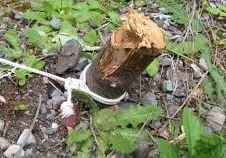To know the meaning of the term stake, it is necessary, first of all, to know its etymological origin. In this case, we can establish that it derives from Gothic, specifically from “stakka”, which can be translated as “post” or even “stick”.
A stake is a stick that has a sharp end . Thanks to this particularity, it is an element with different uses, since it can be stuck into the ground.
 Stakes are used to fix a tent or tent . By driving the stakes, the ropes that lift the structure can be anchored. For example: “Don't lose the stakes while I set up the tent,” “This type of tent requires six stakes,” “Despite the stakes, the shelter ended up blowing away due to the strong winds.”
Stakes are used to fix a tent or tent . By driving the stakes, the ropes that lift the structure can be anchored. For example: “Don't lose the stakes while I set up the tent,” “This type of tent requires six stakes,” “Despite the stakes, the shelter ended up blowing away due to the strong winds.”
In the context of the armed forces, stakes are sticks that allow the creation of stakes : fortifications or defensive barriers. Stockades are formed by driving the stakes into the ground and creating a containment system.
Another use of stakes is linked to aggression and even torture . Impalement is a method of execution in which the victim was impaled or nailed with a stake. In the field of mythology, it is said that one of the ways to kill a vampire is to drive a stake into its heart.
In the same way we cannot ignore the existence of a song that has the term in question in its title. We are referring to “L´Estaca”, which can be translated as “The Stake”. It was composed in 1968 by the Catalan singer-songwriter Lluís Llach and has become a symbol of freedom. And it was created during the dictatorship of Francisco Franco with the purpose of calling for unity to break the ties and achieve the aforementioned freedom.
If we focus on botany , we can say that a cutting is a stem or branch that lacks roots but can be planted so that a new specimen emerges. The stake, therefore, is separated from a bush or tree and buried in a substrate with the aim of rooting in it. If the procedure is successful, the plant soon begins to grow and develop. That is why cuttings constitute a form of vegetative propagation.
In addition to everything indicated, we cannot ignore the existence of a geographical feature that has the word we are addressing in its name. We are referring to Cape Estaca de Bares, which is located in Mañón, in the province of La Coruña, and which stands out for two things: for being the northernmost point of Spain and because it determines the separation between the Atlantic Ocean and the Cantabrian Sea.
The term in question is also used in the field of mining. And in that sector, a stake is a unit used to measure areas in countries such as Chile, Bolivia or Peru, for example. Not forgetting the Castilian stake that is 0.84 meters.
